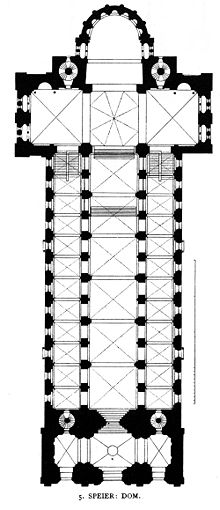Bound system
The bound system is the typical construction scheme of a Romanesque basilica .
description
In the churches of the early Middle Ages, the effect of the central and side aisles is determined by the parallel arrangement of the rooms . The naves are separated by massive, regular pillar arcades . The main nave has a flat ceiling , a barrel vault or belt vault . In the structure of a three-aisled basilica, one yoke of the main nave corresponds to one or two yokes of the side aisles. A linear spatial impression prevails.
The bound system creates a closer spatial relationship between the ships with an optical cross connection . The development of the cross vault made it possible to switch between thicker and thinner pillars. At the four corners of a yoke in the main nave, four strong pillars form a square in the floor plan. In the side aisles, this square is followed by two half-length squares, each corresponding to a yoke. The intermediate pillars were usually made lighter so that a rhythmic structure is created.
Examples
The bound system can be seen in the floor plan of the Speyer Cathedral : one yoke in the main nave corresponds to two yokes in the side aisles, the change of support is recognizable. The bound system in Germany was probably founded on this building at the end of the 11th century, as the later added vaults of the central nave had to refer to the narrow aisle vaults that were already there. Due to the enormous span of the vaults, with an even yoke sequence (a central nave yoke corresponds to a side nave yoke), strongly transverse rectangular vault units would have been created. To avoid this, two axes of the central nave were combined to form a yoke. The vault-bearing pillars were in the nave with additional wall projections (a pilaster reinforced submitted three quarters column). Further examples of the immediate successor can be found in Worms Cathedral and in Eberbach Monastery .
See also
literature
- dtv atlas architecture . Volume 2. 13th edition. dtv, Munich 2005, ISBN 3-423-03021-6 .
- Wilfried Koch: Architectural style . 27th edition. Wissen Media Verlag, Gütersloh / Munich 2006, ISBN 3-577-10089-3
- Hans Koepf : Picture dictionary of architecture . Alfred Kröner Verlag, Second Edition, Stuttgart 1985, ISBN 3-520-19402-3 , p. 168

